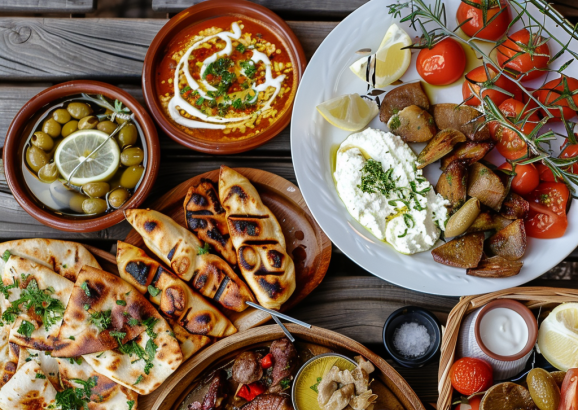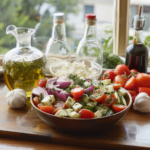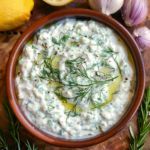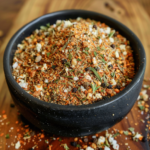
Explore Authentic Greek Cuisine: Discovering the Heart of Greek Cuisine
Explore Authentic Greek Cuisine: While Greece’s azure waters, pristine beaches, and ancient ruins are undeniably captivating, the true soul of this historic land lies in its rich culinary traditions. Growing up in a Greek American household, I was always aware of the extraordinary flavors that set Greek cuisine apart. Instead of mundane holiday dishes, our family feasted on homemade spanakopita, each layer buttery and crisp, and dolmades fresh from the grape leaves in our garden.
Greek cuisine offers an array of dishes that reflect its landscape and history, from the mountains to the Mediterranean sea. Whether you plan to visit Greece or want to bring a taste of Greek culinary excellence into your home, exploring this vibrant cuisine is a journey worth taking. Here, I’ll introduce you to seven quintessential Greek dishes that promise a palate-expanding experience. So, even if a trip to Greece isn’t on your itinerary, a visit to a local Greek restaurant or a homemade Greek meal can transport your senses to this enchanting land.
Delve into the vibrant world of Greek cuisine, where each dish tells a story of cultural heritage and culinary ingenuity. From the bustling street markets of Athens to the quaint tavernas dotting the Aegean coastline, Greek food offers a diverse palette that caters to every taste. In this guide, “Explore Authentic Greek Cuisine: 15 Essential Dishes Every Food Lover Must Try,” we embark on a delicious journey through the heart of Greece.
You’ll discover not only the flavors that have defined Greek cooking for centuries but also the techniques and traditions that turn simple ingredients into extraordinary meals. Whether you’re an adventurous foodie or someone seeking to bring new recipes into your kitchen, these 15 essential dishes provide a perfect starting point for exploring the richness of Greek culinary traditions. Join us as we unveil the secrets behind the irresistible charm of authentic Greek dishes, from the world-renowned Souvlaki to the less known but equally delightful Melitzanosalata.
1. Souvlaki
Perhaps one of Greece’s most famous culinary exports, Souvlaki features small pieces of skewered pork, chicken, or lamb that have been marinated in a mix of lemon, olive oil, and traditional spices before grilling. This dish exemplifies the Greek knack for turning simple ingredients into a delicious and hearty meal. Souvlaki is typically served wrapped in a soft pita with tzatziki, tomatoes, onions, and a sprinkle of paprika.
2. Moussaka
Explore Authentic Greek Cuisine: Moussaka is a rich, layered bake often described as Greece’s answer to lasagna. It primarily consists of sliced eggplant and ground meat, topped with a béchamel sauce and baked to golden perfection. Each layer is seasoned with nutmeg and cinnamon, offering a distinctive flavor that makes Moussaka a comforting and satisfying dish.
3. Tzatziki
Explore Authentic Greek Cuisine: This iconic Greek dip or condiment is made from thick yogurt, grated cucumber, garlic, olive oil, and fresh dill. Tzatziki is refreshing and cool, making it the perfect accompaniment to grilled meats or a simple spread for fresh bread. It’s a staple side dish that no Greek meal would be complete without.
4. Fasolada
Explore Authentic Greek Cuisine: Often called the national dish of Greece, Fasolada is a bean soup that showcases the Greek philosophy of using a few quality ingredients to great effect. Made with white beans, olive oil, and vegetables, this soup is traditionally consumed during the cold winter months and is revered for its high nutritional value.
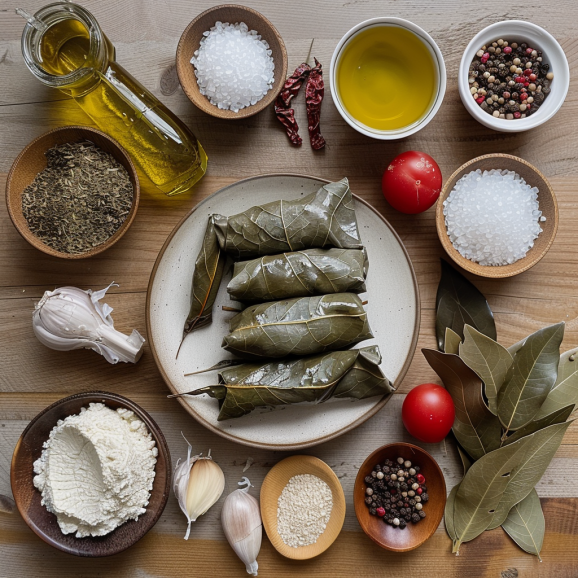
5. Dolmades
Explore Authentic Greek Cuisine: Dolmades are grape leaves stuffed with rice, pine nuts, and fresh herbs. They can be served cold or at room temperature and often include a squeeze of lemon juice on top. This dish can be found in other cuisines of the former Ottoman regions, but the Greek version emphasizes the use of fresh dill and mint.
6. Spanakopita
Explore Authentic Greek Cuisine: Spanakopita, or spinach pie, is a staple snack or appetizer in Greek cuisine. It’s made with crispy phyllo pastry layers, packed with a savory mixture of spinach, feta cheese, onions, and herbs. This pie is as nutritious as it is tasty and can be enjoyed any time of day.
7. Baklava
Explore Authentic Greek Cuisine: Baklava, the sweet pastry made of layers of phyllo filled with chopped nuts and sweetened with syrup or honey, is a dessert that spans many Middle Eastern and Mediterranean countries. The Greek version uses walnuts or almonds and is flavored with cinnamon and clove.
8. Gyro
Explore Authentic Greek Cuisine: A close relative of Souvlaki, Gyro is made with meat cooked on a vertical rotisserie, traditionally pork, or chicken in Greece. It’s served wrapped in a pita and garnished with a range of condiments including tzatziki, onions, lettuce, and tomatoes.

9. Horiatiki Salata
Explore Authentic Greek Cuisine: Also known as Greek village salad, Horiatiki Salata consists of tomatoes, cucumbers, onions, green bell pepper, olives, feta cheese, olive oil, and seasoned with salt and dried oregano. It’s fresh, colorful, and bursting with flavors.
10. Pastitsio
Explore Authentic Greek Cuisine: This baked pasta dish features layers of penne pasta, minced meat, and a creamy béchamel sauce. Often referred to as Greek lasagna, Pastitsio is a hearty and beloved family meal within Greek households.
11. Saganaki
Explore Authentic Greek Cuisine; Named after the sagani, a small frying pan, Saganaki is typically a fried cheese dish served piping hot. It’s crisp and gooey, often flambéed with a splash of brandy table-side, leading to its dramatic presentation.
12. Melitzanosalata
Explore Authentic Greek Cuisine: A flavorful eggplant dip, Melitzanosalata is made with roasted or grilled eggplant, garlic, lemon juice, and olive oil. This dish is a testament to the Greek knack for turning simple produce into delightful dips that are both healthy and delicious.
13. Kleftiko
Explore Authentic Greek Cuisine: A slow-cooked lamb dish that gets its name from the Greek word for “thieves,” Kleftiko is seasoned with garlic, onions, peppers, tomatoes, and feta cheese, all wrapped in parchment paper and cooked until the meat falls off the bone.
14. Galaktoboureko
Explore Authentic Greek Cuisine: A sumptuous custard pie, Galaktoboureko is made with creamy semolina custard encased in golden, crispy phyllo. After baking, the dessert is soaked in a sweet syrup, creating a delightful contrast of texture and flavor.
15. Octopus
Grilled octopus is a Greek island specialty, prepared simply with olive oil, lemon, and oregano. The key is the freshness of the seafood and its preparation, resulting in a tender, flavorful dish that’s often enjoyed beside the sea.
Explore Authentic Greek Cuisine: Conclusion
From savory delights like Souvlaki and Moussaka to sweet treats like Baklava, Greek cuisine offers a dish for every palate. It’s a culinary tradition steeped in history and enhanced by the geography and climates of the region. Each dish tells a story of cultural fusion and culinary innovation. As you explore these 15 must-try traditional Greek dishes, you’re not just sampling flavors; you’re experiencing pieces of Greek heritage and the timeless beauty of Mediterranean cooking.
Explore Authentic Greek Cuisine FAQ: Greek Cuisine
Q1: What makes Greek cuisine unique? A1: Greek cuisine is characterized by its use of fresh ingredients, including olive oil, herbs, grains, fish, and various meats, including lamb and poultry. What makes it unique is its foundation in ancient traditions combined with regional influences from Asia Minor and the Middle East, creating a rich variety of flavors and dishes.
Q2: Are there vegetarian options in Greek cuisine? A2: Absolutely! Greek cuisine offers numerous vegetarian dishes that are both nutritious and flavorful. Popular options include Dolmades (stuffed grape leaves), Spanakopita (spinach pie), and a variety of dips such as Tzatziki and Melitzanosalata (eggplant dip).
Q3: What are some typical spices and herbs used in Greek cooking? A3: Greek cooking commonly uses oregano, mint, garlic, onion, dill, and bay laurel leaves. These herbs and spices are essential for creating the aromatic flavors that Greek cuisine is known for.
Q4: Is Greek food healthy? A4: Greek food is considered quite healthy, especially as it is a part of the Mediterranean diet, which is known for its benefits in reducing the risk of heart disease and promoting overall longevity. The cuisine includes a balance of high-quality meats and seafood, a variety of vegetables, and healthy fats such as olive oil.
Q5: What is a traditional Greek dessert? A5: One of the most famous Greek desserts is Baklava, a sweet pastry made of layers of phyllo dough filled with chopped nuts, sweetened with syrup or honey. Another beloved dessert is Galaktoboureko, a custard pie baked between layers of phyllo and soaked in syrup.
Q6: Can Greek dishes be easily prepared at home? A6: Yes, many Greek dishes can be prepared at home with readily available ingredients. Dishes like Souvlaki, Tzatziki, and Horiatiki Salata require basic ingredients and simple cooking techniques that can be adopted by home cooks.
Q7: What is a typical Greek meal structure? A7: A typical Greek meal often starts with a variety of mezes, small dishes that include dips, vegetables, and small pieces of meat or seafood. This is followed by a main dish, often featuring grilled meat or fish, and concludes with a dessert such as Baklava or fresh fruit.
Q8: What should I know about Greek wines? A8: Greek wines are diverse and underappreciated. Varieties such as Assyrtiko, Moschofilero, and Agiorgitiko are excellent and offer unique flavors that pair wonderfully with Greek dishes. Greece’s climate allows for the production of both robust reds and crisp whites that enhance the flavors of Greek cuisine.
Q9: How important are seafood dishes in Greek cuisine? A9: Seafood plays an integral role in Greek cuisine, especially in coastal regions and the islands. Fresh fish, octopus, and calamari are commonly grilled or baked with a light seasoning of olive oil, lemon, and herbs.
Q10: Are there any special cooking techniques unique to Greek cuisine? A10: Traditional Greek cooking techniques include grilling over open flames (common for meats like lamb and seafood), baking in earthenware pots, and preparing foods with olive oil and lemon, a technique known as “ladolemono.” These methods bring out the natural flavors of the ingredients used in Greek dishes.
Explore Authentic Greek Cuisine: Chef on a Bike: Your Beacon in the Odyssey of Greek Culinary Exploration”
Chef on a Bike is more than a platform; it embodies a vibrant community where the zeal for Greek culinary traditions is nurtured and celebrated. As you step into our realm, you’re enveloped in an atmosphere enriched with the affection for hearty Greek meals, the invigorating aroma of fresh herbs, and the camaraderie encapsulated in sharing a meal.
Our mission, although simple, resonates deeply; it’s about bridging the culinary journey between the novice and the seasoned cook, melding ancient traditions with contemporary twists, and creating a warm enclave for Greek cuisine aficionados and the comforting ambiance of a Greek kitchen. Our platform unveils a treasure trove of authentic recipes, enlightening narratives, and interactive cooking sessions helmed by passionate Greek chefs, whose every stir, chop, and simmer encapsulates the heart of Greek culinary ethos.






